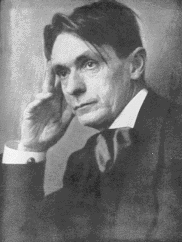If you are just beginning to explore this site and the work of Rudolf Steiner, you may have some questions.
Rudolf Steiner

During the last two decades of the nineteenth century, the Austrian-born Rudolf Steiner (1861–1925) became a respected and well-published scientific, literary, and philosophical scholar, particularly known for his work on Goethe's scientific writings. After the turn of the century, he began to develop his earlier philosophical principles into an approach to methodical research of psychological and spiritual phenomena.
His multi-faceted genius has led to innovative and holistic approaches in medicine, science, education (Waldorf schools), special education, philosophy, religion, economics, agriculture (Bio-Dynamic method), architecture, drama, the new art of eurythmy, and other fields. In 1925 he founded the General Anthroposophical Society, which today has branches throughout the world.
Read a longer version by Michael Wilson (from the introduction to The Philosophy of Freedom). See also Memories of Rudolf Steiner by Ludwig Graf Polzer-Hoditz, a personal friend of Steiner, for vivid recollections of the early anthroposophical movement.
Fundamentals
With twenty-seven books and thousands of lectures to choose from, it can be daunting to begin.
Start with Steiner's five basic books.
Rudolf Steiner intended these carefully written volumes to serve as a foundation to all of the later, more advanced anthroposophical writings and lecture courses.
We recommend the following approach:
- Read Theosophy and Knowledge of Higher Worlds.
- Explore the many lectures for topics that pique your interest. Lectures numbered GA 95-125 are good ones with which to start. "GA numbers" represent the volumes which make up Steiner's collected works (GesammtAusgabe).
- Then read Steiner's other seminal books: Occult Science, The Philosophy of Freedom and Christianity as a Mystical Fact.
You may then wish to turn to the following collection of fifty select lectures to provide an overview of Steiner's work.
Adolph Arenson's Top 50 Lecture Cycles
In 1930 Adolph Arenson published his monumental three-volume concordance titled Ein Führer Durch die Vortragszyklen Rudolf Steiners (1–50)—“A Guide to the Lecture Cycles of Rudolf Steiner (1–50)” (Berlin, Selbstverlag, Not Translated). This work—now out of print and exceedingly rare—is of the greatest aid to the student who can read German. Works presented here are those lecture cycles in the Arenson 1–50 which have been translated into English.
Why is Steiner's work so challenging?
As Dr. Steiner explained in 1915:
“How often does the demand arise, again and again: ‘Why are the books written in a way so difficult to understand? Could they not be written in a simpler fashion?’ And someone or another makes suggestions as to how these books could be written for the people and made popular. One must really beware of gaining such popularity, for it only enhances egotism. If it were made so easy to enter Spiritual Science then each one could enter without overcoming his egotism. But in the work accomplished spiritually by the efforts we have to make, we get rid of a little of our egotism; we enter what we wish to acquire through Spiritual Science in a more hallowed frame of mind if we have had to take trouble over it, than if it had been presented to us in quite an easy and popular form.
For example, a person has come home and said: ‘There are so many people who have to work all day long. If these people have to sit down in the evening to read these difficult books, they do not get on very well. For such as these there ought to be books quite easy to read.’
To this I had to answer – and quite correctly: ‘Why should one prevent these people from applying even the little time at their disposal to reading such books as are purposely written with full regard to spiritual conditions? Why should they occupy the little time they have in reading books which may be more convenient, but which trivialise the matter even textually?’ For it is just because these books do not place the soul in the right attitude, that they drag down into the trivial life that which should lead one away from it, even as regards the nature of the experience connected with another sphere.
It will become of special importance in Spiritual Science that we should bear in mind not only the ‘What’ (the matter) but the ‘How’ (the manner): that we should really bestir ourselves gradually to acquire ideas of a world quite different from the ordinary physical world, and thus gradually to accustom ourselves to form conceptions different from those we can build so comfortably in the physical world.”—Rudolf Steiner, The Forming of Destiny and Life after Death, Lecture 4: The Connection Between The Spiritual And The Physical Worlds, And How They Are Experienced After Death, GA 157a, Berlin, December 7, 1915.

